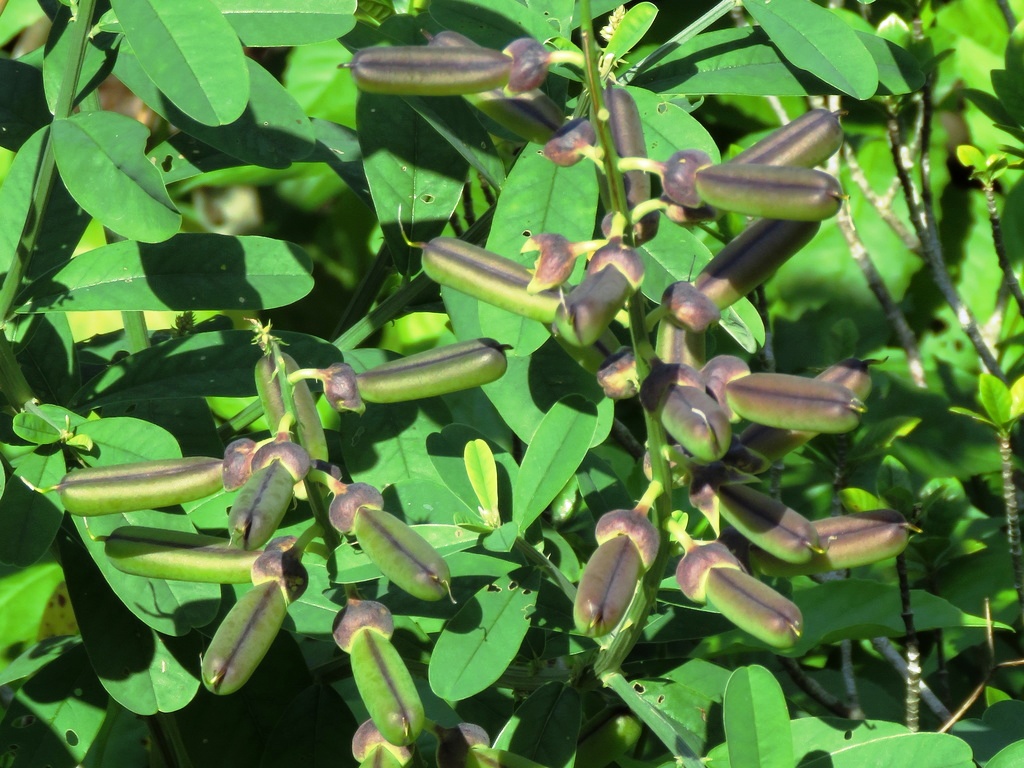Crotalaria retusa

|
|
Crotalaria retusa Common Names: Devil-bean, Rattleweed, Shack shack,
Wedge-leaf rattlepod, Rattlebox Scientific
Classification Kingdom: Plantae Clade: Tracheophytes Clade: Angiosperms Clade: Eudicots Clade: Rosids Order: Fabales Family: Fabaceae Subfamily: Faboideae Genus: Crotalaria Species: C. retusa Synonyms: Crotalaria cuneata G.Don, Crotalaria dependens Klotzsch, Crotalaria guineensis DC., Crotalaria retusiloba Stokes Morphological Description Crotalaria retusa is an annual herbaceous plant, typically growing 30–150 cm
tall, with erect, angular, green branches. Its key characteristics include: · Stem: Slender, glabrous to slightly pubescent, often branching
near the base, with a woody texture in older plants. · Leaves: Simple, alternate, obovate to narrowly oblong (3–7 cm × 1–3
cm), dark green above, lighter beneath, with a wedge-shaped base and rounded
apex . · Flowers: Yellow, pea-like, 1–2 cm long, arranged in terminal or
axillary racemes; each flower has a standard petal with reddish veins and a
keeled base.. · Fruit and Seeds: Inflated pods (2–4 cm long), green turning
black, containing 10–20 small, kidney-shaped seeds that rattle when dry, giving
the plant its common name "rattlepod". Distribution and Habitat Crotalaria retusa has a broad distribution, with an unclear native range but
significant presence in tropical regions: · Geographic Range: Likely native to tropical Asia, Africa,
and Australia; widely naturalized in the Americas (USA, Brazil, Cuba), Pacific
Islands, and India; listed as a noxious weed in several U.S. states (e.g.,
Florida, Hawaii), Puerto Rico, and the Virgin Islands. · Habitat: Thrives in disturbed areas, including roadsides, cultivated
fields, grasslands, and waste grounds; prefers well-drained, sandy or loamy
soils (pH 5.5–7.0) with annual rainfall of 500–1,500 mm; found at elevations up
to 1,500 m. · Ecological Role: Acts as a pioneer species in disturbed
ecosystems; its nitrogen-fixing roots enhance soil fertility, but its
invasiveness threatens native flora. Ethnopharmacology While Crotalaria retusa is primarily known for its toxicity, some
traditional uses have been documented, though caution is advised due to its pyrrolizidine
alkaloids (PAs): It is known for
antimicrobial, anti-inflammatory, antioxidant, antimalarial, and wound-healing
properties. Traditionally, it has been used to treat skin infections, fevers,
respiratory issues, rheumatism, and diarrhea. The plant contains flavonoids,
alkaloids, tannins, and phenolic compounds, which contribute to its therapeutic
effects. However, Crotalaria retusa also contains pyrrolizidine alkaloids,
compounds that are potentially hepatotoxic (liver-damaging) when consumed in large
or prolonged doses. Therefore, while it has recognized medicinal value, its use
requires caution and proper dosage to avoid toxicity · Anti-inflammatory
and Antinociceptive Activities: Albumins extracted from Crotalaria retusa seeds demonstrated
significant anti-inflammatory and pain-relieving effects in experimental
models. In carrageenan-induced paw edema tests, the albumin fraction at 10
mg/kg reduced edema by 58.3% after 4 hours, comparable to indomethacin. In the
acetic acid-induced writhing test, it decreased writhes by 64.7%, indicating
potent antinociceptive activity (Aragão et al., 2017). · Antioxidant
and Antidiabetic Properties: Phytochemical analyses of C. retusa roots revealed alkaloids,
saponins, tannins, cardiac glycosides, steroids, and flavonoids, contributing
to its antioxidant and potential antidiabetic activities. The methanolic root
extract exhibited a DPPH radical scavenging activity with an IC50 of 78.6 µg/mL
and inhibited α-glucosidase activity by 42.3% at 100 µg/mL, suggesting its potential
in managing oxidative stress and hyperglycemia (Das et al., 2023). · Antimicrobial
Activity: C. retusa extracts
displayed antimicrobial properties against pathogens such as Staphylococcus
aureus and Escherichia coli, with minimum inhibitory concentrations (MICs)
ranging from 125 to 500 µg/mL. These effects are attributed to pyrrolizidine
alkaloids and phenolic compounds, supporting its traditional use in treating
infections (Bezerra et al., 2011). ⚠ Toxicity Profile: Crotalaria retusa contains pyrrolizidine alkaloids (e.g.,
monocrotaline, 4.4% in seeds), which are hepatotoxic, cytotoxic, and oncogenic.
Acute toxicity (LD₅₀ 500–1,000 mg/kg in rats) causes liver necrosis, pulmonary
lesions, and CNS damage. In Australia, horses develop "Kimberley Horse
Disease" or "walkabout disease" after grazing for 3–4 weeks,
with death occurring in 3 months to 2 years; symptoms include weight loss,
jaundice, ataxia, and aimless wandering. In the USA, seeds are toxic to
poultry, causing high mortality at 0.1% dietary inclusion. Human consumption of
contaminated grains or honey poses risks of veno-occlusive disease. Chronic
exposure may lead to liver fibrosis and cancer. Use is contraindicated in
pregnancy and for children due to heightened sensitivity (Everist, 1979;
Stegelmeier et al., 2016; Lacerda et al., 2021). Additional Uses · Agricultural: Grown as a green manure and cover crop to improve soil
fertility through nitrogen fixation; used as a fiber crop in India.. · Ornamental: Occasionally planted for its bright yellow flowers in
tropical gardens, though its invasiveness limits this use. · Ecological Impact: As an invasive species, it displaces
native plants and reduces biodiversity in grasslands and farmlands; listed as a
noxious weed in the USA, India, and Cuba. · Agricultural Impact: Contaminates crops like oats, reducing
yield and quality; poses a risk to livestock through contaminated feed. References
External Links More Pictures |
|
| Compounds of Crotalaria retusa | |
| References |